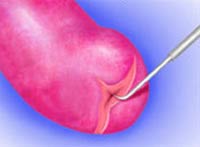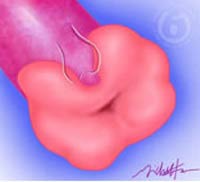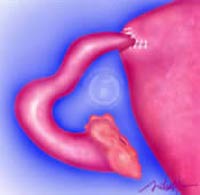Tubal Repair Surgery
For Blocked Tubes: Explained
Not only do we specialize in tubal ligation reversal, but we also offer patients tubal repair surgery for blocked fallopian tubes.
Most of our patients travel to our center for reversal of tubal ligation, but we also have patients who come for tubal surgery to repair fallopian tubes blocked from scar tissue.
Often this scar tissue has formed because of a previous pelvic infection, surgery, or an ectopic pregnancy. This scar tissue can often form either at the beginning or at the end of the fallopian tube.
Tubal blockage caused by scar tissue can often be repaired with microsurgical tubal surgery. This can allow many women an alternative to in-vitro fertilization and the chance to become pregnant naturally.
Hydrosalpinx: Repairing tubal blockage at the end of tube
The most common type of tubal blockage is when scar tissue forms at the very end of the fallopian tubes. This causes the tubal fimbria (the area of the tube where they egg is received from the ovary) to close. This type of tubal scar tissue will prevent pregnancy from occurring.

When the tubal blockage is severe the fallopian tube will swell with fluid and the swollen tube is often called a tubal hydrosalpinx.
A hydrosalpinx can be repaired with a microsurgical salpingostomy procedure. During this procedure the scar tissue is removed and the end of the tube is reopened. This surgical repair will allow pregnancy to occur.
Fimbriectomy: When tubal ligation is done at the end of the tube

This type of tubal ligation procedure is uncommon and is called a fimbriectomy tubal ligation.
Fimbriectomy can be repaired with a microsurgical salpingostomy and allow women the ability to become naturally pregnant.
Salpingostomy procedure: Opening up blocked tubes
When the tubes are blocked either from a hydrosalpinx or fimbriectomy this can be repaired with a microsurgical salpingostomy procedure.
The chance of pregnancy after microsurgical salpingostomy depends on the age of the patient and the health and length of the remaining tube.
The pregnancy rate at one year after salpingostomy is approximately 30% to 40%.
Tubal blockage at the beginning of the tube
It is less common to have blockage at the beginning of the fallopian tube. The most common reason to have blockage at the beginning of the fallopian tube is from an Essure sterilization procedure. The next most common reason to have blockage at the beginning of the tube is from Salpingitis Isthmica Nodosa (SIN).
Salpingitis Isthmica Nodosa is a condition which is not very well understood but often occurs in the beginning of the fallopian tube as it travels through the muscle of the uterus.
This condition causes progressive tubal scarring that can cause patients to have multiple ectopic (tubal) pregnancies. Ultimately this condition can progress to complete tubal blockage.
This condition can often be reversed through a tubouterine implantation procedure. We commonly perform tubouterine implantations for reversal of Essure sterilization, but this type of tubal repair can also correct blockage in the beginning part of the tube from other causes.
The pregnancy rate one year following tubouterine implantation ranges from 25 to 50%.

